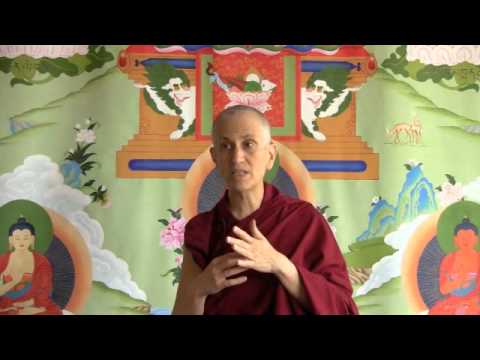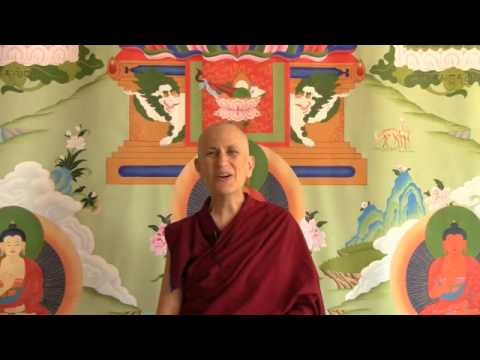Six perfections and three higher trainings
Stages of the Path #116b: The Fourth Noble Truth
Part of a series of Bodhisattva's Breakfast Corner talks on the Stages of the Path (or Lamrim) as described in the Guru Puja text by Panchen Lama I Lobsang Chokyi Gyaltsen.
- Ordinary versus higher trainings
- How motivation is key
- How the higher trainings fit together within the six perfections
We’ve been talking about the three higher trainings. The three trainings and the three higher trainings are different in the sense that the three trainings of ethical conduct, concentration, and wisdom are geared more towards worldly aims. The three higher trainings are geared toward supramundane aims.
-
Ethical conduct, just as a regular training, you do to attain a higher rebirth, whereas the higher training in ethical conduct is done with the long-term purpose of liberation in mind.
-
Similarly with the ordinary training in concentration, it’s in order to be born in the different form and formless concentrations, but those are all rebirths within samsara, whereas the higher training in concentration is aimed at liberation.
-
Similarly with wisdom, the regular training of wisdom is more for some benefit within samsara, whereas the higher training of wisdom is aimed at liberation.
Also, with the three higher trainings you can put the six perfections, there’s a way of including them within the three higher trainings.
-
Far-reaching generosity is seen as the basis for the three higher trainings, everything depends on generosity.
-
Far-reaching ethical conduct is included in the higher training of ethical conduct.
-
Far-reaching fortitude is included in the higher training of concentration because when you’re developing fortitude and deepening your compassion you really need to be able to hold the mind there without letting it waver.
-
In far-reaching joyous effort, meditative stabilization, and wisdom are included in the higher training of wisdom.
Instead of included in we should say “correspond with” or “associated with.”
You’re going to ask, “Well, why is it? It would seem that the far-reaching meditative stabilization should be with the higher training in concentration.” In one way it should. But the way I’m talking about it now is when you go through the bodhisattva bhumis (the grounds or levels of a bodhisattva)–and there are ten of those grounds–then at each of those grounds one of the ten far-reaching practices reaches an unsurpassed level. We’re talking about those first six (which actually include all ten) when they are reaching that unsurpassed level as you go through the bodhisattva bhumis.
-
Far-reaching generosity becomes unsurpassed on the first bhumi. That’s the basis for the three higher trainings.
-
Far-reaching ethical conduct becomes unsurpassed on the second bhumi.
-
Far-reaching fortitude goes with the higher training in concentration.
-
Far-reaching joyous effort, meditative stabilization, and wisdom are perfected, or reach unsurpassing level on the fourth, fifth, and sixth of the bodhisattva levels. So those are correlated with the higher training in wisdom. Those three (fourth, fifth, and sixth bhumis) you’re also developing special wisdom during them.
-
In the fourth bhumi you’re developing special wisdom and facility in the 37 Harmonies with Enlightenment, that’s on the fourth bhumi. That’s the coarse and gross 37 harmonies.
-
The coarse and gross four noble truths, those become really unsurpassed and perfected on the fifth bhumi, so that’s included in the higher training in wisdom.
-
Special understanding of the 12 links of dependent arising, in forward and reverse order, is developed on the sixth bhumi, so that’s also associated with the higher training in wisdom.
These three higher trainings can be explained in terms of somebody who’s aiming for arhatship, but the way I just explained them right there is clearly for somebody who’s on the bodhisattva vehicle.
It was a lot of words, but if you just draw it out in a diagram it’s very simple.
Audience: Does this mean that they don’t really become higher trainings until we reach the first bhumi, that before that we’re just aspiring to that?
Venerable Thubten Chodron (VTC): When you say a “training,” a training implies a whole big…. You train, isn’t it? Training involved time and practice. Then trainings get perfected where they reach a certain level of excellence at a certain time in your practice. That doesn’t mean that you don’t practice them before that time. It doesn’t mean that you don’t practice them after that time. It just means that at that specific bhumi or level then they achieve a certain level of depth.
Audience: So it’s your motivation not your level of attainment that makes the difference between the three trainings and the three higher trainings….
VTC: It’s not only your motivation but how you’re using those trainings. If you’re going to use, let’s say, concentration, you can use concentration just to create the immutable karma so that you get born in that rebirth, that level of form or formless absorption in your next life. Or you can use that concentration and then use it to meditate on wisdom and combine shamatha and vipassana in a transmundane way (there’s also ordinary vipassana and ordinary shamatha). So it depends not just on your motivation but how you use those skills that you develop.
Venerable Thubten Chodron
Venerable Chodron emphasizes the practical application of Buddha’s teachings in our daily lives and is especially skilled at explaining them in ways easily understood and practiced by Westerners. She is well known for her warm, humorous, and lucid teachings. She was ordained as a Buddhist nun in 1977 by Kyabje Ling Rinpoche in Dharamsala, India, and in 1986 she received bhikshuni (full) ordination in Taiwan. Read her full bio.


